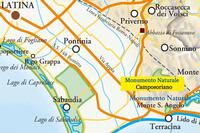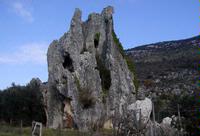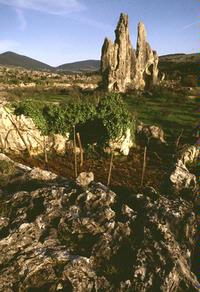 |
|
|
|
MONUMENTO NATURALE CAMPOSORIANO – COMUNI DI TERRACINA, SONNINO
Torna all'elenco It is the “oldest”, having been set up in 1985, and a “relevant geological formation”. From a geomorphological point of view, Camposoriano is a “polje”, a Slavic term indicating a closed Karstic depression, with a flat plain surrounded by more or less steep slopes. The monument extends across approx. 975 hectares and is categorised by the extraordinary variety of karstic forms found there. The most striking of these is the so-called Cathedral or “Rava di San Domenico”, a kind of spire, with vertical etchings, sheets of rock, and breeches, which rises over 10 meters from ground level and soars above the many other smaller ones that stud the area. The “Cathedral” is a “Hum” (hummock), i.e. an isolated ridge produced by erosion, typical of karstification. The bed of the Campo is covered with fertile “red earth”, typical sedimentary deposits of residues from the chemical break-up of limestone and numerous “doline”, “lapiez”, that is, rising rocks fluted by copious grooves. There are also “swallow holes” in the bed, the deepest being the Chiavica di Zi’ Checca (approx. 120 m.), not far from the Cathedral. “Extreme” karstification and rocks are not the only features of Camposoriano. There are wells inhabited by amphibians, such as the Italian newt, and the earth flourishes with three-toed skinks, blindworms and other species of reptiles. The entire area is also the home of at least seventy species of birds (among birds of prey, the most frequently seen are the peregrine falcon, buzzard, screech owl, owl and scops owl) and mammals, such as the badger, fox, stone marten, porcupine and Apennine wolf. Still present in relative abundance is the typical vegetation of Mediterranean scrub: Holm oak, sessile oak, cork, turkey oak, some Turkish-cork oak, lentisk shrubs, Spanish broom, spurge laurel and many species of herbaceous plants. A visit to the Natural Monument can be done by mountain bike, by following the various narrow roads and paths. One begins at the Visitors’ Centre, following the west slope and riding around the Monte Cavallo Bianco; or, on foot, following both the asphalted and “dirt” roads, and rather easy footpaths. Information: Office of the Natural Monument, Camposoriano, tel. 0773700240. (Bruno Maragoni - maragoni@latinaturismo.it) For in-depth information, please download the brochure "Latina, provincia verde, provincia blu " from the page "Le nostre pubblicazioni " in the main menu
|
 |
La Riviera d'Ulisse - Ente Turistico di Terzo Settore
Servizio IAT - Informazione ed Assistenza al Turista Largo Jacopo Peri, 70 - Latina - tel. 0773480672 - 0773484502 - 06/69281723 www.larivieradulisse.it - www.larivieradulisse.it - www.latinaeventi.it - info@latinaturismo.it a cura di Cooperiamo Insieme Cooperativa Sociale P.I. 02812020598 |
powered by iper.net |
|



